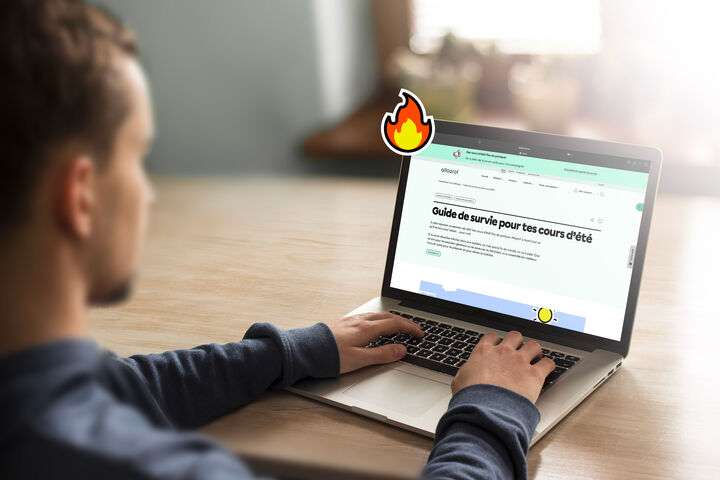Même si la pandémie n’est pas tout à fait terminée, le retour en classe et la fin de l’année scolaire qui approche nous donnent le goût de croire que les allers-retours entre enseignement à distance et à l’école seront sur pause bientôt. Toutefois, l’enseignement à distance a fait ses preuves et certains établissements continueront d’offrir des scénarios hybrides ou complètement en ligne l’an prochain.
Jusqu’à maintenant, que retenons-nous de la façon d’entretenir le lien avec les élèves à distance? C’est en déployant une bienveillance « 3D » que nous favorisons une relation positive! Que sont ces « 3D »?
DONNER : jamais trop
Liens vidéos, documents à lire, ressources numériques, tutoriels, rétroaction, commentaires, astuces… Un élève qui a un coffre à outils bien garni sera en mesure d’atteindre les objectifs de façon plus autonome et en toute confiance. Un élève qui fait des apprentissages en dehors de la salle de classe a avantage à mieux se connaître comme apprenant afin de cibler des méthodes efficaces. En ayant accès à des contenus différents, il peut tester et apprendre à travailler de manière optimale pour lui.
Il est cependant important de classer les ressources afin qu’elles soient clairement reliées aux contenus. Par exemple, si la leçon porte sur la phrase de base et que l’on fournit des liens vidéos pour chacun des constituants, des pages Web à consulter ainsi que des exercices interactifs à réaliser, on doit s’assurer que chaque contenu soit jumelé avec l’objectif d’apprentissage visé, tels que repérer le sujet, le prédicat ou le complément de phrase. Comment? Sous forme de tableau, dans une sous-catégorie sur la plateforme de partage de classe ou dans un Digipad, par exemple.
DÉCRIRE : mieux vaut prévenir que guérir
Lors d’un atelier de coaching, Marius Bourgeoys d’escouadeÉDU a dit : « être clair, c’est être gentil ». C’est probablement vrai dans tous les contextes. Rien n’est pire pour l’engagement d’un élève qu’une consigne imprécise ou difficile à interpréter.
Comment rendre une consigne plus claire? Par exemple, en offrant à l’élève des références pertinentes qui pourront l’appuyer, en lui offrant une consigne vidéo accompagnée d’une liste à cocher ou en fournissant les directives par écrit. Lorsque les élèves ont à travailler sur une production pendant plusieurs périodes, il est intéressant de leur demander d’envoyer l’évolution de celle-ci à différents moments afin de les guider et de leur offrir une rétroaction.
DEMANDER : en équipe, on va plus loin
Quand vous recevez votre facture dans un restaurant, celle-ci contient souvent un message vous invitant à compléter un sondage en ligne afin de donner votre opinion sur la qualité du service reçu. Pourquoi ne pas faire exactement la même chose dans un contexte scolaire?
Sondez vos élèves en leur posant des questions comme :
- Avez-vous aimé la vidéo que j’ai partagée hier? Était-elle claire, trop longue, trop courte?
- L’application choisie pour effectuer la production écrite est-elle facile à utiliser? Si non, en auriez-vous une autre à me proposer?
- Qu’aimez-vous lire sur le Web? Connaissez-vous un bon site de nouvelles?
- Quelle plateforme préférez-vous entre Google Forms et Quizziz pour effectuer une révision?
Un des principaux défis lorsque les élèves ne sont pas physiquement en classe, c’est de favoriser leur engagement. En leur donnant des outils, en leur décrivant les attentes et en leur demandant leur avis, l’enseignant les amène à prendre part plus activement à leurs apprentissages et les conduit ainsi vers l’engagement.
Finalement, la bienveillance, c’est aussi « 3D » parce c’est réel! Les élèves ont besoin d’être mis au premier plan et de faire partie intégrante de chacune des réflexions et des choix de leurs enseignants. Il faut voir au-delà des programmes, des Meet/Teams/Zoom, des obligations, des horaires. Il faut voir les humains qui s’adaptent et qui sont, somme toute, tout à fait résilients et surtout merveilleux.






